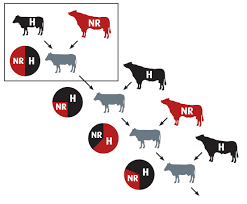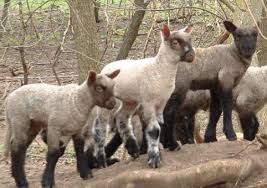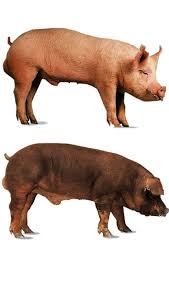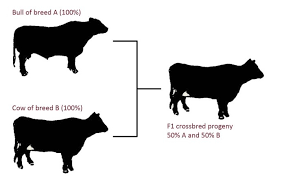Cross breeding is a reproductive technique that involves mating two distinct breeds or varieties of plants or animals to produce offspring with desired traits from both parents.
This practice is commonly used in agriculture and animal husbandry to enhance specific characteristics such as growth rate, disease resistance, or adaptability to different environmental conditions. By combining the genetic materials of two different genetic lines, cross breeding can create hybrids that may exhibit improved performance, resilience, and productivity compared to their parent stock.
In the plant world, cross breeding is often employed to develop new crop varieties that can withstand pests, diseases, or harsh climatic conditions. For instance, farmers may cross a high-yielding variety of corn with a disease-resistant variety to produce a hybrid that not only produces more grains but also is less susceptible to crop failures.
This method allows for the introduction of beneficial traits while maintaining the overall vigor and health of the plants. The resulting hybrids can often yield higher produce, which is essential for meeting the increasing food demands of a growing global population.
Similarly, in animal breeding, cross breeding is used to combine the best traits of different breeds. For example, crossing a beef cattle breed known for its high meat quality with a breed recognized for its rapid growth can result in offspring that grow quickly while also producing high-quality meat.
This approach not only benefits farmers by increasing productivity but also contributes to the sustainability of livestock production. Cross bred animals often show heterosis or hybrid vigor, where the offspring outperform their parents in various traits, such as growth rate and reproductive performance.
Cross breeding is not without its challenges. Breeders must carefully select parent breeds to ensure compatibility and the desired traits in the offspring. There is also the risk of producing animals or plants that may have undesirable characteristics if the selection process is not managed properly.
Furthermore, cross breeding can lead to a loss of genetic diversity if the practice is not balanced with conservation efforts for pure breeds. This is why it is essential for breeders to maintain detailed records and follow ethical practices to ensure the long-term viability of both the hybrids and the parent stocks.
In addition to enhancing productivity and resilience, cross breeding plays a significant role in addressing global challenges such as climate change and food security.
As environmental conditions continue to change, developing crops and livestock that can thrive in less-than-ideal situations becomes increasingly important. Through careful cross breeding practices, researchers and farmers can develop varieties that not only yield well but also require fewer resources, such as water and fertilizers.
Overall, cross breeding is a valuable tool in modern agriculture and animal husbandry. It provides a pathway for innovation and improvement, allowing farmers and breeders to respond to evolving market demands and environmental challenges.
As technology advances, techniques such as molecular breeding and genetic markers are increasingly integrated into cross breeding programs, further enhancing the efficiency and effectiveness of producing new varieties.
This ongoing development promises to play a crucial role in sustaining agricultural productivity and meeting the needs of future generations.
History of Cross Breeding

The history of cross breeding dates back thousands of years, as humans have long sought to improve plants and animals through selective breeding practices. The roots of cross breeding can be traced to ancient agricultural societies that recognized the benefits of combining traits from different varieties to enhance food production and livestock quality.
In ancient Mesopotamia, farmers practiced selective breeding of crops, such as wheat and barley, to create varieties that were more resilient to pests and diseases.
They discovered that by choosing seeds from the best-performing plants, they could gradually improve crop yields over generations. This early form of selective breeding laid the foundation for more systematic approaches to cross breeding.
The domestication of animals also played a crucial role in the development of cross breeding practices. Early pastoralists recognized that certain traits in livestock, such as size, temperament, and productivity, could be enhanced by breeding animals with desirable characteristics.
For example, the ancient Egyptians bred cattle for milk production and strength, while the Chinese focused on breeding pigs for size and meat quality. These practices helped establish the importance of selective breeding in animal husbandry.
As agricultural practices evolved, so did the techniques for cross breeding. In the 18th century, scientists began to formalize breeding methods through the work of pioneers like Robert Bakewell in England.
Bakewell is credited with developing systematic breeding techniques for sheep and cattle, focusing on traits such as weight gain and wool quality. His methods emphasized the importance of maintaining detailed records and selecting breeding stock based on performance, which laid the groundwork for modern breeding practices.
The 19th century brought significant advancements in the understanding of genetics, particularly with the work of Gregor Mendel. Mendel’s experiments with pea plants in the 1860s revealed the principles of inheritance and how traits could be passed down through generations.
His findings provided a scientific basis for cross breeding and allowed breeders to make more informed decisions when selecting parent plants or animals. Although Mendel’s work went largely unrecognized during his lifetime, it eventually became foundational for the field of genetics and breeding.
In the early 20th century, the advent of new scientific techniques further transformed cross breeding practices. The development of hybridization techniques allowed breeders to create hybrids with specific traits, leading to significant improvements in crop yields and livestock productivity.
For example, the Green Revolution of the 1960s, characterized by the use of high-yielding varieties of staple crops, was made possible by cross breeding techniques that enhanced disease resistance and adaptation to various climates.
Today, cross breeding continues to evolve, incorporating modern technologies such as molecular genetics and genomic selection. These advancements enable breeders to identify desirable traits more efficiently and develop new varieties with greater precision.
With the ongoing challenges posed by climate change, food security, and sustainable agriculture, cross breeding remains a vital tool for enhancing food production and improving the resilience of crops and livestock.
Importance of Cross Breeding in Agriculture
1. Genetic Diversity: Cross breeding increases genetic diversity within a species, which can enhance resilience to diseases, pests, and environmental changes. A diverse gene pool allows crops and livestock to adapt better to changing conditions.
2. Improved Traits: By combining the desirable traits of different varieties or breeds, cross breeding can lead to the development of new strains with enhanced characteristics such as higher yield, better quality, and improved nutritional value.
3. Disease Resistance: Cross breeding can result in plants and animals with improved resistance to diseases and pests. This is particularly important in agriculture, where crop failures and livestock losses can have significant economic impacts.
4. Increased Productivity: Cross breeding often results in hybrid vigor (heterosis), where offspring exhibit better growth rates, higher fertility, and greater overall productivity compared to their parents.
5. Adaptability: Cross breeding can help create varieties that are better suited to specific environmental conditions, such as drought resistance or salt tolerance, ensuring food security in diverse climates.
6. Economic Benefits: Improved traits from cross breeding can lead to higher market prices for crops and livestock, benefiting farmers economically. Increased productivity also means more food available for consumers.
Read Also: 5 Medicinal Health Benefits of Scutellaria nana (Dwarf Skullcap)
Methods of Cross Breeding

1. Selective Breeding: This traditional method involves choosing parent plants or animals with specific desirable traits to produce offspring. Over several generations, traits can be enhanced and stabilized within the population.
2. Hybridization: Hybridization involves crossing two different species or varieties to produce hybrids. These hybrids often possess desirable traits from both parents, such as increased yield or disease resistance.
3. Backcrossing: In backcrossing, a hybrid offspring is crossed with one of its parent strains to reinforce desired traits. This method helps incorporate specific traits from one parent while maintaining the genetic background of the other.
4. Genetic Engineering: Advanced techniques, such as genetic modification, involve directly altering the genetic material of plants or animals. This method can introduce specific traits without traditional cross breeding.
5. Gene Editing: Techniques like CRISPR allow for precise modifications to an organism’s DNA. This method can enhance desirable traits or eliminate undesirable ones without introducing foreign genes.
Types of Cross Breeding Techniques
1. Intraspecific Cross Breeding: This technique involves crossing individuals within the same species. For example, different varieties of wheat may be crossed to enhance specific traits like yield or disease resistance.
2. Interspecific Cross Breeding: This technique crosses different but related species. For example, crossing two species of beans can create hybrids that combine the best traits of both, such as increased yield or pest resistance.
3. Controlled Cross Breeding: In this method, breeders manually control the mating of individuals to ensure specific traits are combined. This approach allows for precise outcomes and helps avoid unintended genetic combinations.
4. Natural Cross Pollination: Some plants rely on natural agents like wind or insects for pollination. This method can lead to cross breeding without human intervention, although it may result in less predictable traits.
5. Artificial Insemination (AI): In livestock, AI is a common technique where semen from a selected male is artificially introduced into a female. This method allows for the use of superior genetics from distant or superior breeds.
6. Embryo Transfer: In this technique, embryos from a superior female are implanted into surrogate mothers. This allows for the rapid multiplication of desirable traits across a larger population.
Advantages of Cross Breeding
1. Enhanced Genetic Traits: Cross breeding often results in offspring with superior qualities, such as improved growth rates, higher yields, and better disease resistance. This genetic improvement can lead to more robust crops and livestock.
2. Hybrid Vigor (Heterosis): Many hybrids exhibit hybrid vigor, meaning they perform better than their parents in terms of growth, fertility, and survival. This can translate to higher productivity in both plants and animals.
3. Increased Adaptability: Cross bred plants and animals can be more resilient to environmental stresses, such as drought, extreme temperatures, and pests, improving their chances of survival and success in various conditions.
4. Greater Diversity: By introducing new genetic material, cross breeding increases the genetic diversity within a population. This diversity is crucial for long-term sustainability, as it allows populations to adapt to changing environmental conditions.
5. Economic Benefits: Improved traits and increased productivity can lead to higher profits for farmers and breeders. Cross breeding can produce more marketable products, enhancing overall economic viability.
Disadvantages of Cross Breeding
1. Inbreeding Depression: If not managed carefully, cross breeding can lead to inbreeding depression, where offspring exhibit reduced fitness and viability due to a limited gene pool. This can result in lower productivity and increased susceptibility to diseases.
2. Complexity in Management: Cross breeding programs require careful planning and management to achieve desired traits. This complexity can be resource-intensive and may require specialized knowledge.
3. Unpredictable Outcomes: The results of cross breeding can be unpredictable, and not all offspring may exhibit the desired traits. This variability can lead to challenges in achieving consistent quality in products.
4. Time-Consuming Process: Developing new varieties or breeds through cross breeding can take several generations, making it a time-consuming process. This can delay the introduction of improved varieties to the market.
5. Potential Loss of Heritage Traits: Focusing on specific traits in cross breeding may result in the loss of traditional or heritage traits that are important for cultural or ecological reasons.
Read Also: 10 Medicinal Health Benefits of Ficus religiosa (Sacred Fig)
Cross Breeding in Animal Husbandry

1. Improved Livestock Performance: In animal husbandry, cross breeding is used to enhance desirable traits such as growth rate, milk production, and disease resistance. For example, crossing beef cattle breeds can yield animals with better meat quality.
2. Increased Fertility Rates: Cross breeding can lead to higher fertility rates and better reproductive performance in livestock, contributing to more efficient breeding programs.
3. Customized Breeds: Farmers can create specific breeds tailored to their production goals, whether for meat, milk, or other purposes. This customization allows for better alignment with market demands.
4. Conservation of Rare Breeds: Cross breeding can also aid in the conservation of endangered breeds by introducing new genetic material, helping to prevent extinction while maintaining desirable traits.
Cross Breeding in Plant Breeding
1. Development of High-Yield Varieties: In plant breeding, cross breeding is used to develop high-yielding varieties that can significantly increase food production. This is essential for meeting the demands of a growing global population.
2. Improved Resistance to Pests and Diseases: Cross breeding allows for the integration of pest and disease resistance traits from one plant variety to another, reducing the need for chemical pesticides and enhancing sustainability.
3. Enhanced Quality Attributes: Cross breeding can improve the quality of fruits and vegetables, such as flavor, texture, and nutritional value, making them more appealing to consumers.
4. Adaptation to Local Conditions: Breeders can create varieties that are better suited to local environmental conditions, such as drought resistance or salt tolerance, ensuring successful cultivation in diverse regions.
Ethical Considerations in Cross Breeding
1. Animal Welfare: In animal husbandry, cross breeding practices must prioritize the welfare of the animals involved. Ethical concerns arise regarding the health and well-being of hybrid animals, especially if they are bred for extreme traits.
2. Biodiversity Concerns: Cross breeding can potentially threaten biodiversity if certain hybrid varieties or breeds dominate the market, leading to the neglect or extinction of traditional varieties.
3. Food Security: Ethical considerations must also address the impact of cross breeding on food security, ensuring that improved varieties contribute positively to local food systems without compromising access to food for vulnerable populations.
4. Transparency and Consumer Awareness: Breeders and farmers should be transparent about their cross breeding practices and the traits of the resulting products. Consumers have the right to know about the genetic background of the foods they consume.
5. Regulatory Frameworks: Ethical cross breeding requires adherence to regulations and guidelines that ensure the safety and efficacy of new breeds and varieties, protecting both consumer interests and environmental sustainability.
Do you have any questions, suggestions, or contributions? If so, please feel free to use the comment box below to share your thoughts. We also encourage you to kindly share this information with others who might benefit from it. Since we can’t reach everyone at once, we truly appreciate your help in spreading the word. Thank you so much for your support and for sharing!
Read Also: Homeowners Insurance Complete Guide

